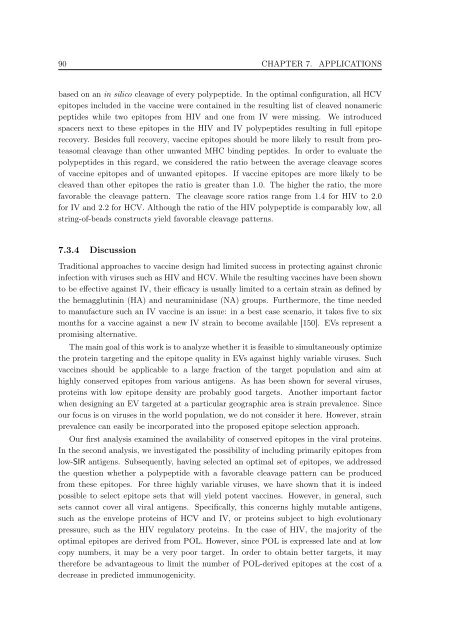New Approaches to in silico Design of Epitope-Based Vaccines
New Approaches to in silico Design of Epitope-Based Vaccines
New Approaches to in silico Design of Epitope-Based Vaccines
Create successful ePaper yourself
Turn your PDF publications into a flip-book with our unique Google optimized e-Paper software.
90 CHAPTER 7. APPLICATIONS<br />
based on an <strong>in</strong> <strong>silico</strong> cleavage <strong>of</strong> every polypeptide. In the optimal configuration, all HCV<br />
epi<strong>to</strong>pes <strong>in</strong>cluded <strong>in</strong> the vacc<strong>in</strong>e were conta<strong>in</strong>ed <strong>in</strong> the result<strong>in</strong>g list <strong>of</strong> cleaved nonameric<br />
peptides while two epi<strong>to</strong>pes from HIV and one from IV were miss<strong>in</strong>g. We <strong>in</strong>troduced<br />
spacers next <strong>to</strong> these epi<strong>to</strong>pes <strong>in</strong> the HIV and IV polypeptides result<strong>in</strong>g <strong>in</strong> full epi<strong>to</strong>pe<br />
recovery. Besides full recovery, vacc<strong>in</strong>e epi<strong>to</strong>pes should be more likely <strong>to</strong> result from proteasomal<br />
cleavage than other unwanted MHC b<strong>in</strong>d<strong>in</strong>g peptides. In order <strong>to</strong> evaluate the<br />
polypeptides <strong>in</strong> this regard, we considered the ratio between the average cleavage scores<br />
<strong>of</strong> vacc<strong>in</strong>e epi<strong>to</strong>pes and <strong>of</strong> unwanted epi<strong>to</strong>pes. If vacc<strong>in</strong>e epi<strong>to</strong>pes are more likely <strong>to</strong> be<br />
cleaved than other epi<strong>to</strong>pes the ratio is greater than 1.0. The higher the ratio, the more<br />
favorable the cleavage pattern. The cleavage score ratios range from 1.4 for HIV <strong>to</strong> 2.0<br />
for IV and 2.2 for HCV. Although the ratio <strong>of</strong> the HIV polypeptide is comparably low, all<br />
str<strong>in</strong>g-<strong>of</strong>-beads constructs yield favorable cleavage patterns.<br />
7.3.4 Discussion<br />
Traditional approaches <strong>to</strong> vacc<strong>in</strong>e design had limited success <strong>in</strong> protect<strong>in</strong>g aga<strong>in</strong>st chronic<br />
<strong>in</strong>fection with viruses such as HIV and HCV. While the result<strong>in</strong>g vacc<strong>in</strong>es have been shown<br />
<strong>to</strong> be effective aga<strong>in</strong>st IV, their efficacy is usually limited <strong>to</strong> a certa<strong>in</strong> stra<strong>in</strong> as def<strong>in</strong>ed by<br />
the hemagglut<strong>in</strong><strong>in</strong> (HA) and neuram<strong>in</strong>idase (NA) groups. Furthermore, the time needed<br />
<strong>to</strong> manufacture such an IV vacc<strong>in</strong>e is an issue: <strong>in</strong> a best case scenario, it takes five <strong>to</strong> six<br />
months for a vacc<strong>in</strong>e aga<strong>in</strong>st a new IV stra<strong>in</strong> <strong>to</strong> become available [150]. EVs represent a<br />
promis<strong>in</strong>g alternative.<br />
The ma<strong>in</strong> goal <strong>of</strong> this work is <strong>to</strong> analyze whether it is feasible <strong>to</strong> simultaneously optimize<br />
the prote<strong>in</strong> target<strong>in</strong>g and the epi<strong>to</strong>pe quality <strong>in</strong> EVs aga<strong>in</strong>st highly variable viruses. Such<br />
vacc<strong>in</strong>es should be applicable <strong>to</strong> a large fraction <strong>of</strong> the target population and aim at<br />
highly conserved epi<strong>to</strong>pes from various antigens. As has been shown for several viruses,<br />
prote<strong>in</strong>s with low epi<strong>to</strong>pe density are probably good targets. Another important fac<strong>to</strong>r<br />
when design<strong>in</strong>g an EV targeted at a particular geographic area is stra<strong>in</strong> prevalence. S<strong>in</strong>ce<br />
our focus is on viruses <strong>in</strong> the world population, we do not consider it here. However, stra<strong>in</strong><br />
prevalence can easily be <strong>in</strong>corporated <strong>in</strong><strong>to</strong> the proposed epi<strong>to</strong>pe selection approach.<br />
Our first analysis exam<strong>in</strong>ed the availability <strong>of</strong> conserved epi<strong>to</strong>pes <strong>in</strong> the viral prote<strong>in</strong>s.<br />
In the second analysis, we <strong>in</strong>vestigated the possibility <strong>of</strong> <strong>in</strong>clud<strong>in</strong>g primarily epi<strong>to</strong>pes from<br />
low-SIR antigens. Subsequently, hav<strong>in</strong>g selected an optimal set <strong>of</strong> epi<strong>to</strong>pes, we addressed<br />
the question whether a polypeptide with a favorable cleavage pattern can be produced<br />
from these epi<strong>to</strong>pes. For three highly variable viruses, we have shown that it is <strong>in</strong>deed<br />
possible <strong>to</strong> select epi<strong>to</strong>pe sets that will yield potent vacc<strong>in</strong>es. However, <strong>in</strong> general, such<br />
sets cannot cover all viral antigens. Specifically, this concerns highly mutable antigens,<br />
such as the envelope prote<strong>in</strong>s <strong>of</strong> HCV and IV, or prote<strong>in</strong>s subject <strong>to</strong> high evolutionary<br />
pressure, such as the HIV regula<strong>to</strong>ry prote<strong>in</strong>s. In the case <strong>of</strong> HIV, the majority <strong>of</strong> the<br />
optimal epi<strong>to</strong>pes are derived from POL. However, s<strong>in</strong>ce POL is expressed late and at low<br />
copy numbers, it may be a very poor target. In order <strong>to</strong> obta<strong>in</strong> better targets, it may<br />
therefore be advantageous <strong>to</strong> limit the number <strong>of</strong> POL-derived epi<strong>to</strong>pes at the cost <strong>of</strong> a<br />
decrease <strong>in</strong> predicted immunogenicity.

















